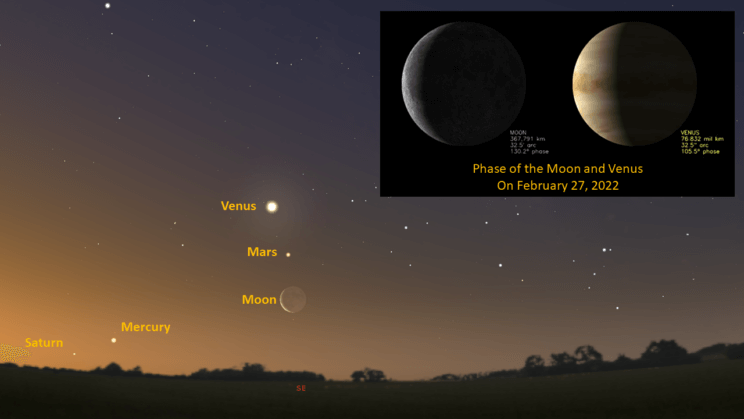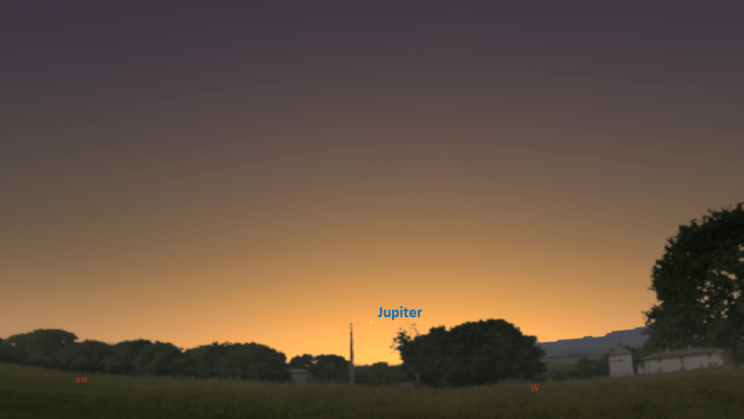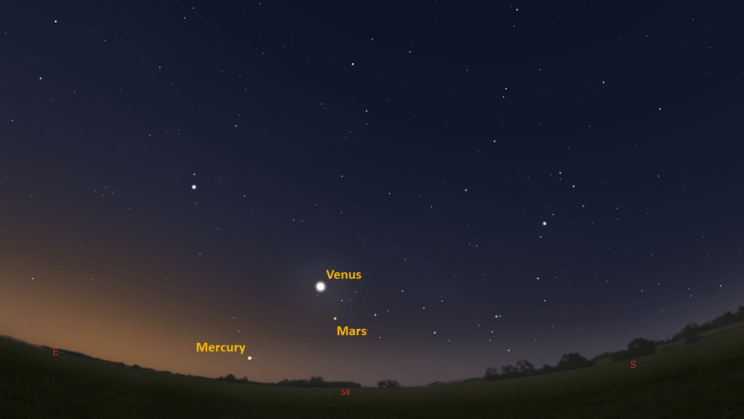This is the Saint Louis Science Center’s NIGHT SKY UPDATE for the week of Friday, February 18, 2022.
Information updated weekly or as needed.
Times given as local St. Louis time which is Central Standard Time (CST). For definitions of terminology used in the night sky update, click the highlighted text. If relying on times posted in Universal Time (UT), St. louis is -6 hours when CST.
Public Telescope Viewings
With the changing recommendations from the CDC regarding COVID-19, conversations regarding the return of star parties at the Saint Louis Science Center have begun. We are close to bringing back our public telescope viewings, but a few details still need to be worked out. We will post future updates as we learn more about when we can bring back telescope viewings.
Observing Highlight of the Week

The Moon, Mars and Venus seen at 6:00 am in the southeast on February 27, 2022. Sky image was created using Stellarium. Simulated phase images created using NASA Solar System Simulator v4.0.
The southeast sky just before sunrise is becoming busy with planets. Most of the naked eye planets that were visible at the end of last year, have shifted to visibility in the morning. The only planet that remains in the southwest after sunset is Jupiter but not for long. Jupiter will soon be lost to the Sun’s glare as it approaches superior conjunction on March 5, 2022. Jupiter will eventually shift to the morning sky joining the rest of the naked eye planets.
Except for Saturn, the other naked eye planets are now seen before sunrise in the southeast around 6:00 a.m. The always elusive Mercury is now headed back towards the Sun’s glare as it approaches superior conjunction on April 2, 2022. Those with a clear view of the southeast may still catch a few views of Mercury. A good rule of thumb is to aim for views about 30 to 40 minutes before sunrise. Unfortunately, using that time frame, Mercury is less than 10° above the horizon. For most of us that means Mercury will be too low to see.
Saturn is slowly climbing out of the Sun’s glare. Currently it remains too low to be seen but that will change by mid-March. Saturn reaches opposition on September 26, 2022. As we head to this date, Saturn will become visible earlier each day. Saturn becomes visible before midnight by July and fall 2022 is when Saturn will be at its best. Saturn will exhibit an appulse and conjunction with Venus on March 28/29 and Mars on April 4.
This month, the best display of planets is seen before sunrise on February 27, 2022. For those willing to look around 6:00 a.m., you will find the Moon, Mars and Venus together in the southeast. The Moon and Venus will both exhibit crescent phases. The Moon will show 13.3% of the lunar disk illuminated while the disk of Venus will be 37% illuminated. To see the phase of Venus you will need a telescope or large binoculars but use caution and make sure the Sun has not risen. The Moon, Mars and Venus will appear in a near straight vertical line. This is a nice reminder that the Moon and planets may all shift along a similar path, but they all have their own unique orbital planes.
Venus and Mars will remain the best planets target for a while but soon Saturn and Jupiter will join the mix. We can look forward to these giant planets returning this spring.
The Sun and Moon

The Moon as seen from the International Space Station, on July 31, 2011.
Credit: NASA
Sunrise is at 6:48 a.m. on Friday, February 18 and sunset is at 5:42 p.m. providing us with roughly 11 hours of daylight. Even after sunset, the light from the Sun will dimly illuminate our sky for roughly 1 hour and 30 minutes. This period is called twilight, which ends around 7:11 p.m. this week. For those with a sundial, local noon occurs around 12:14 a.m. this week.
| Day | Sunrise | Sunset |
|---|---|---|
| 2022-02-18 | 6:48 a.m. | 5:42 p.m. |
| 2022-02-19 | 6:46 a.m. | 5:43 p.m. |
| 2022-02-20 | 6:45 a.m. | 5:44 p.m. |
| 2022-02-21 | 6:44 a.m. | 5:45 p.m. |
| 2022-02-22 | 6:42 a.m. | 5:46 p.m. |
| 2022-02-23 | 6:41 a.m. | 5:47 p.m. |
| 2022-02-24 | 6:40 a.m. | 5:48 p.m. |
| 2022-02-25 | 6:38 a.m. | 5:50 p.m. |
| 2022-02-26 | 6:37 a.m. | 5:51 p.m. |
Moon
Moonrise for Friday, February 18 occurs at 7:55 p.m. and moonset will occur at 8:34 a.m. on the following day. On Friday, February 18 the Moon will exhibit a waning gibbous phase with 97% of the lunar disk illuminated. Last quarter moon occurs on February 23, 2022, at 4:33 p.m.
International Space Station (ISS) Observing

Visible passes of ISS from St. Louis for the week of February 18 occur during morning hours. The best passes this week occur on February 19 and 20. Use the table below for information about these and other visible passes this week.
Catch ISS from St. Louis starting Friday, February 18
| Date | Starts | Max. altitude | Ends | |||||||
|---|---|---|---|---|---|---|---|---|---|---|
| Time | Alt. | Az. | Time | Alt. | Az. | Time | Alt. | Az. | ||
| 19 Feb | -1 | 04:39:45 | 13 | SSE | 04:40:38 | 14 | SE | 04:42:30 | 10 | E |
| 19 Feb | -3.6 | 06:13:45 | 10 | WSW | 06:17:03 | 56 | NW | 06:20:21 | 10 | NE |
| Feb 20 | -3.8 | 05:27:10 | 28 | SW | 05:28:48 | 81 | SE | 05:32:10 | 10 | NE |
| 21 Feb | -2.2 | 04:41:23 | 35 | E | 04:41:23 | 35 | E | 04:43:48 | 10 | ENE |
| 21 Feb | -2.4 | 06:14:40 | 10 | W | 06:17:28 | 24 | NNW | 06:20:16 | 10 | NNE |
| 22 Feb | -3 | 05:28:21 | 31 | WNW | 05:29:04 | 36 | NNW | 05:32:13 | 10 | NE |
| 23 Feb | -2 | 04:42:15 | 28 | NE | 04:42:15 | 28 | NE | 04:44:03 | 10 | NE |
| 24 Feb | -1.9 | 05:28:56 | 17 | NW | 05:29:30 | 18 | NNW | 05:31:54 | 10 | NNE |
| 25 Feb | -1.4 | 04:42:36 | 18 | NNE | 04:42:36 | 18 | NNE | 04:43:52 | 10 | NNE |
Magnitude (Mag): The Measure of brightness for a celestial object. The lower the value is, the brighter the object will be.
Altitude (Alt): The angle of a celestial object measured upwards from the observer’s horizon.
Azimuth (Az): The direction of a celestial object, measured clockwise from an observer’s location with north being 0°, east being 90°, south being 180° and west being 270°.
For information about ISS flyovers and other visible satellites, visit www.heavens-above.com
Detailed information regarding all unmanned exploration of our universe, missions past, present, and planned, can be found at Jet Propulsion Laboratories:
The Visible Planets

Looking southwest, at 6:00 p.m. February 18, 2022. Credit: Stellarium, EG

Looking southeast, at 6:00 am, February 19, 2022. Credit: Stellarium, EG
This week, three naked eye planets are visible. Jupiter is visible in the southwest after sunset. Venus and Mars are seen in the southeast before sunrise.
Venus
Venus has started a morning apparition and will be seen in the southeast before sunrise. Venus can be found rising by 4:17 and should be easy to spot in the southeast by 5:00 a.m. This morning apparition lasts until the third week of October 2022. Venus reaches superior conjunction on October 22, 2022.
Mars
A new apparition for Mars has begun. Mars rises at 4:44 a.m. Start looking for Mars around 5:30a.m. as it clears trees and buildings. Mars will continue to climb out of the Sun’s glare as it heads towards opposition later this year on December 7, 2022.
Jupiter
Look for Jupiter in the southwest as it starts to darken outside. Jupiter sets at 6:31 p.m. and will set about 20 minutes earlier each week. Jupiter reaches superior conjunction on March 5, 2022. Jupiter is below the 10° threshold so you will need a clear horizon to easily spot the giant planet.
James S. McDonnell Planetarium
Night Sky Update: February 18 – February 26, 2022






